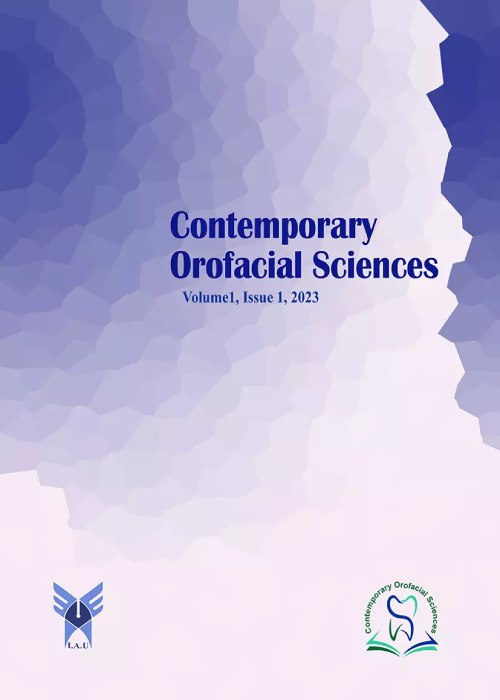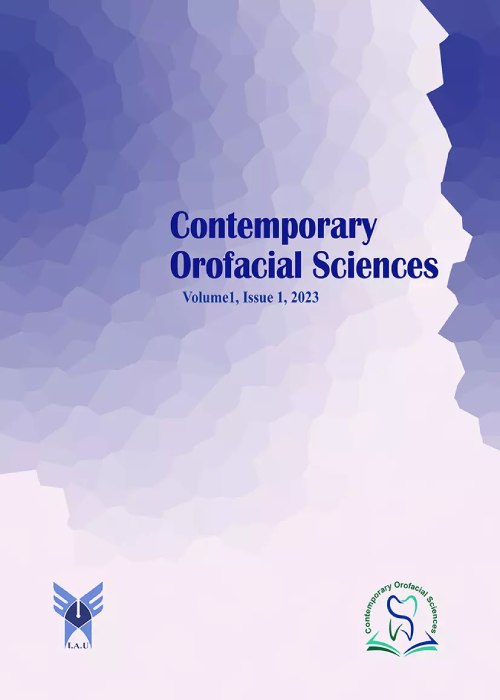فهرست مطالب

Contemporary Orofacial Sciences
Volume:1 Issue: 1, Spring 2023
- تاریخ انتشار: 1402/02/11
- تعداد عناوین: 8
-
Page 0
-
Pages 1-5Background
This study assessed the effect of propolis and 2% chlorhexidine (CHX) on push-out bond strength of fibre post-cemented with resin cement.
Materials and MethodsThis in-vitro, experimental study evaluated 36 extracted human mandibular premolars in three groups (n=12). After root canal cleaning and shaping, propolis and 2% CHX gel were applied as an intracanal medicament in groups 1 and 2, respectively. Group 3 received no medicament. The access cavity was sealed, and the teeth were incubated for one week. The root canals were obturated and post space was prepared using the #2 Angelus drill. After 72 h of incubation, the crowns were cut, and the roots were mounted in acrylic and incubated for one week. The roots were sectioned into apical, middle and coronal thirds and underwent a push-out test. Data were analyzed using ANOVA and Bonferroni and Tukey’s tests.
ResultsThe propolis group showed maximum and minimum bond strength in the middle and coronal thirds, respectively (P>0.05). The CHX group showed the highest and the minimum bond strength in the coronal and middle thirds, respectively (P>0.05). The control group showed maximum and minimum bond strength in the middle and coronal thirds, respectively (P>0.05). The mean bond strength in the propolis group was significantly higher than the control group (P<0.05).
Conclusionusing propolis as intracanal medicament can increase the push-out bond strength of fibre post-cemented with resin cement in the middle third of the root while using CHX increases the push-out bond strength of fibre post in the coronal third.
Keywords: Propolis, Chlorhexidine, Resin Cements, Fibre Post, bond strength -
Pages 6-12Background
Conservative treatment of adhesive dentistry considers demineralized dentin as a bonding substrate, and utilizing silver diamine fluoride (SDF) on demineralized dentin before composite restoration, probably can be beneficial. To evaluate the effect of SDF and potassium iodide (KI) on nano leakage plus the micro tensile bond strength of composite to demineralized dentin in primary teeth.
Materials and MethodsIn this experimental- laboratory study, seventy-eight teeth in the micro tensile group and ninety teeth in the nano leakage group were divided into two groups with sound and demineralized dentin. Each group of teeth was divided into three separate groups. In the first group, bonding was used without pre-treatment. In the second group, the SDF was used before the bonding agent and SDF and, KI was used in the third group. Two-way ANOVA, Bonferroni's post hoc test, Mann-Whitney test and Fisher's exact test were used for data analysis. (α<0.05)
ResultsThe lowest mean bond strength was in the SDF and KI groups in both sound (10.0 ± 1.9) and demineralized (6.8 ± 2.3) dentin groups. Using KI significantly reduced bond strength (P <0.05). Nano leakage in teeth with sound and demineralized dentin in both SDF and SDF and KI groups was significantly lower than in the control groups (P <0.05).
ConclusionUsing SDF does not harm composite bond strength to primary teeth, but using KI after SDF reduces composite bond strength. The use of SDF and KI significantly reduces composite nano leakage.
Keywords: silver diamine fluoride, potassium iodide, Tooth, Deciduous -
Pages 13-16Background
Artificial Intelligence (AI) is a term that implies using a computer to model intelligent behavior with minimal human intervention. Their potential to exploit the meaningful relationship with a dataset can be used in diagnosis, treatment, and outcome prediction in many clinical scenarios. The aim was to evaluate the use of artificial intelligence algorithms to successfully differentiate histopathologic images of grades of OSCC and healthy oral mucosa.
Material & MethodsIn this cross-sectional study, Inception-ResNet-V2, a recently created artificial intelligence system, was used to analyze 844 pictures captured from the histopathological view of the connective tissues from three groups, low-grade OSCC, high-grade OSCC and normal mucosa.
ResultThe results obtained from this research and comparable articles emphasize that deep learning-based systems have a high ability to analyze histopathological images and can be very useful and effective in cancer diagnosis and grading. According to the results of the ROC analysis from this research, Inception-ResNet-V2 has shown robust results in successfully differentiating Low-Grade OSCC, High-Grade OSCC and normal mucosa with over 95% accuracy.
ConclusionAccording to the results of the present and previous studies, it can be concluded that CNN, and particularly Inception-ResNet-V2 have immense potential in analyzing histopathology pictures and could be very helpful for pathologists in cancer diagnosis.
Keywords: Artificial Intelligence, Diagnosis, Oral Squamous Cell Carcinoma, Inception-Resnet-V2 -
Pages 17-21Background
This study aimed to assess MOB1A and B gene polymorphisms in patients with oral lichen planus (OLP. Several of premalignant lesions such as, leukoplakia, erythroplakia, oral lichen planus (OLP), and submucosal fibrosis can undergo malignant transformation and lead to oral cancer and non-invasive screening of patients to find those susceptible to SCC before progression to cancer would be highly beneficial.
Materials and MethodsThis case-control study was conducted on 35 OLP patients and 35 healthy controls presenting to the Oral Medicine Department of Zahedan Dental School 2015 -2017. Unstimulated saliva samples were collected from both groups, and MOB1A and B gene polymorphisms were assessed by polymerase chain reaction (PCR). The two groups were compared by the Chi-square test (alpha=0.05).
ResultsTwo groups had no significant difference in the frequency of T and G alleles for MOB1A gene polymorphisms. (P>0.05) and either two groups had no significant difference in the frequency of A and C alleles for MOB1B gene polymorphism's (P>0.05).
ConclusionThe present results showed no significant difference between the case and control groups regarding MOB1A and B gene polymorphisms; thus, MOB1A and B gene polymorphisms do not appear to play a role in the pathogenesis of OLP.
Keywords: Genes, polymorphisms, MOB1A, MOB1B, Lichen Planus, oral -
Pages 22-28Background
Identification of skeletal remains is crucial in forensic medicine, and one of the important subjects for identifying skeletal remains is sex estimation. the present study aimed to investigate some of the anthropological features of the mandible used for forensic sex estimation with the use of CBCT images.
Materials & MethodsIn this descriptive-analytical study, CBCTs of eighty patients were studied. The studied variables were the mediolateral, and anteroposterior dimensions of the condyle, the ante gonial angle, the longitudinal axis of the condylar angle, and the vertical height of the coronoid process. The above parameters were measured using OnDemand software, and statistical analysis was performed using SPSS software. Independent and Paired T-tests, Discriminant and Receiver operating characteristic (ROC) curves were used for statistical analysis. P values less than 0.05 were considered significant.
ResultsThe condyle mediolateral average dimension for males was significantly higher than for females (p<0.001). Three discriminant analysis models, the first based on the measurements on the right, the second based on the measurements on the left and the third based on mean measurements on both sides, were developed for sex estimation. The area under the receiver operating characteristic (ROC) curve was used for quality assessment of the fitted models and determination of their prediction ability. The ability of all three discriminant models to do sex estimation was obtained by at least 70%. Also, using the ROC curve, the third model was more efficient in sex estimation (area=0.869, p<0.001).
ConclusionThe mediolateral dimension of the mandibular condyle process is a useful parameter in sex estimation. Classification accuracy is more than 80% in all models. Different methods should be used together to make more accurate results of sex estimation and one method alone is not sufficiently advised.
Keywords: Forensic Medicine, Sex estimation, Mandible, Cone beam computed tomography (CBCT), discriminant analysis -
Pages 29-37Background
To uncover evidence of whether immediate implant placement (IIP) significantly reduces horizontal ridge shrinkage?
Materials and MethodsElectronic searches (1980 to September 2021) were performed by two reviewers using PubMed, MEDLINE, and Cochrane Central.
ResultsFindings suggested that IIP using flap-less surgery, atraumatic extraction, 3D positioning, gap grafting with xenograft and customized healing abutments may limit shrinkage similarly to that with socket preservation grafting and delayed implant placement (SPG/DH).
ConclusionsFurther randomized, clinical trials directly comparing IIP and SPG/DH will be needed for confirmation
Keywords: Extraction, Bone, remodeling -
Pages 38-40
A 48-year–old female complained of a growing mass in the right buccal mucosa near maxillary molar teeth from 3 months ago. Clinical examination showed a pink-red sessile nodule (1.5×1×0.5 cm) with a smooth surface. The mass was generally firm and bony hard in palpation in some areas and had a purulent discharge. Clinical, radiographical and pathological evaluations showed that one of the roots of the first maxillary molar was in the lesion. In a review of the literature, there was no similar case report. Diagnostic assessment and clinical management of the lesion were discussed. The review of the literatures there was not even a single similar case report. Diagnostic assessment and clinical management were discussed.
Keywords: Foreign bodies, impacted root, iatrogenic dentistry


